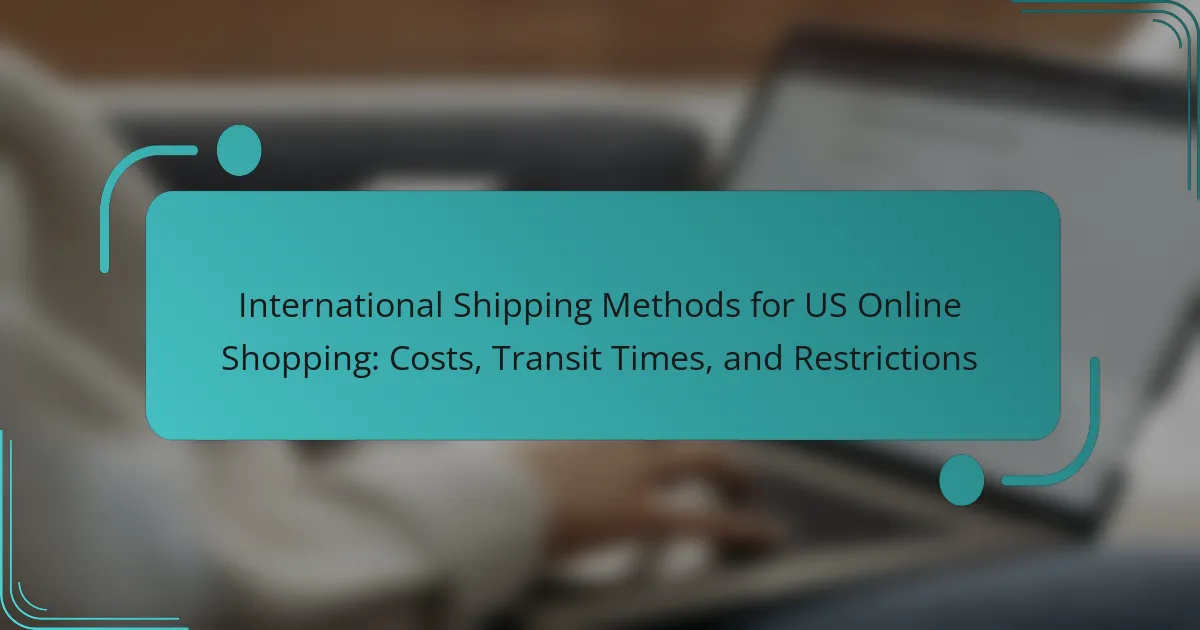
What are the different international shipping methods available for US online shopping?
The different international shipping methods available for US online shopping include standard shipping, expedited shipping, express shipping, and freight shipping. Standard shipping is the most economical option, often taking 2 to 6 weeks for delivery. Expedited shipping offers faster service, typically delivering within 5 to 10 business days. Express shipping is the quickest method, usually ensuring delivery within 1 to 3 business days. Freight shipping is used for large or heavy items, with costs and delivery times varying based on the carrier and destination. Major carriers like USPS, FedEx, UPS, and DHL provide these shipping options, each with specific rates and transit times.
How do various shipping methods differ in terms of cost?
Shipping methods differ significantly in terms of cost based on factors like speed, distance, and service level. Standard shipping is generally the most economical option, often used for non-urgent deliveries. Expedited shipping costs more due to faster transit times and priority handling. Express shipping is the most expensive, offering the quickest delivery, often within one to two days.
Costs also vary by carrier; for example, USPS typically offers lower rates for domestic shipments compared to FedEx or UPS. International shipping costs increase with distance and customs fees, and methods like air freight are pricier than sea freight.
Additionally, package weight and dimensions impact shipping costs. Heavier and larger packages incur higher fees regardless of the shipping method. Seasonal demand can also affect prices, with rates often increasing during peak shopping seasons.
What factors influence the cost of international shipping methods?
The cost of international shipping methods is influenced by several key factors. These factors include the weight and dimensions of the package. Heavier and larger packages generally incur higher shipping costs. Distance also plays a significant role; longer distances typically result in increased shipping fees. The shipping method selected affects costs as well. Air freight is usually more expensive than sea freight.
Customs duties and taxes can add to the total cost. Different countries have varying regulations and fees for imports. Insurance for valuable items can also contribute to shipping costs. Finally, the shipping carrier chosen can impact pricing. Different carriers have different rate structures and service levels.
How do shipping carriers compare in terms of pricing?
Shipping carriers vary significantly in pricing based on service type and delivery speed. For instance, FedEx and UPS typically charge higher rates for express services compared to USPS. USPS often offers more affordable options for lighter packages, especially with its Priority Mail service.
According to the 2023 shipping rate analysis by ShipStation, FedEx’s ground service averages $10.50 for a 5-pound package, while UPS averages $11.00. In contrast, USPS charges around $7.50 for similar weight under Priority Mail.
Additionally, international shipping rates can differ widely. FedEx and UPS often impose higher fees for customs clearance and additional handling. USPS provides more economical international options, such as First-Class Package International Service, which starts at approximately $15.
Overall, pricing comparisons show that USPS generally offers lower rates for lightweight and international shipments, while FedEx and UPS provide faster services at a premium cost.
What are the typical transit times for international shipping methods?
Typical transit times for international shipping methods vary. Express shipping generally takes 1 to 3 business days. Standard shipping usually ranges from 5 to 15 business days. Economy shipping can take 10 to 30 business days. Factors like destination, customs clearance, and carrier efficiency affect these times. For example, shipping from the US to Europe may take 5 to 10 days via standard methods. Shipping to Asia may require 7 to 14 days. Each carrier has specific timeframes, so checking with the chosen service is advisable.
How does transit time vary by shipping method?
Transit time varies significantly by shipping method. Air shipping typically offers the fastest transit times, often ranging from 1 to 5 days. In contrast, sea freight is slower, with transit times averaging between 10 to 40 days depending on the destination. Ground shipping falls in between, usually taking 3 to 10 days. Express shipping services can expedite delivery within 1 to 3 days, especially for domestic routes. Standard shipping methods may take longer, often exceeding 7 days. Factors such as distance, customs processing, and carrier efficiency also influence transit times. According to the Freightos International Freight Index, air shipping is generally 4 to 6 times faster than sea freight.
What are the expected delivery times for different destinations?
Expected delivery times vary by destination. For domestic shipping within the US, delivery typically takes 1 to 5 business days. For Canada, transit times range from 3 to 10 business days. European destinations usually see delivery within 5 to 15 business days. For Asia, expect delivery times of 7 to 20 business days. Australia generally takes 7 to 14 business days for delivery. These times can be affected by factors like customs processing and shipping method chosen.
What restrictions should be considered when choosing an international shipping method?
When choosing an international shipping method, several restrictions must be considered. Customs regulations vary by country and can affect what items can be shipped. Some items may be prohibited or restricted due to local laws. Weight and size limits imposed by shipping carriers can also impact shipping options. Additionally, shipping costs may increase significantly for heavier or larger packages. Insurance requirements may differ, depending on the value of the items being shipped. Delivery times can vary based on the chosen method and destination. Lastly, certain countries may have specific import duties or taxes that must be paid upon arrival. Understanding these restrictions is crucial for successful international shipping.
What types of items are commonly restricted in international shipping?
Items commonly restricted in international shipping include hazardous materials, firearms, and certain food products. Hazardous materials can pose risks during transport. Firearms are often regulated due to safety concerns. Certain food products may be restricted due to import regulations. Additionally, counterfeit goods and items violating intellectual property rights are not allowed. Live animals and plants face restrictions to prevent disease spread. Each country has specific regulations that dictate these restrictions. Compliance with these regulations is crucial for successful shipping.
How do customs regulations impact shipping options?
Customs regulations significantly impact shipping options by determining what goods can be imported or exported. These regulations specify restrictions on certain items, which may limit shipping choices. They also dictate the documentation required for shipments, affecting processing times. Compliance with customs duties and taxes influences overall shipping costs. Non-compliance can lead to delays or confiscation of goods. Different countries have varying regulations, impacting the feasibility of shipping to certain destinations. For example, some countries may have strict import bans on electronics or food products. Therefore, understanding customs regulations is essential for selecting appropriate shipping methods.

What additional factors should be considered when selecting an international shipping method?
When selecting an international shipping method, consider factors such as cost, delivery speed, and reliability. Cost includes shipping fees, customs duties, and taxes. Delivery speed varies based on the carrier and service level chosen. Reliability is measured by the carrier’s track record of on-time deliveries. Additionally, consider the shipping method’s tracking capabilities. Some methods provide real-time tracking, while others offer limited visibility. Insurance options are also important. Higher-value items may require additional coverage during transit. Lastly, review restrictions on items being shipped. Certain products may be prohibited or have specific regulations in different countries.
How do packaging and labeling affect international shipping?
Packaging and labeling significantly influence international shipping by ensuring compliance with regulations and protecting goods. Proper packaging minimizes the risk of damage during transit, which is crucial for maintaining product integrity. Labeling provides essential information such as contents, handling instructions, and destination details. Accurate labels help customs officials process shipments efficiently. Incorrect or missing labels can lead to delays, fines, or return of goods. Additionally, packaging must adhere to specific international standards to prevent contamination or hazards. For example, certain materials may be restricted in specific countries. Overall, effective packaging and labeling streamline the shipping process and enhance the likelihood of successful delivery.
What are the best practices for packaging items for international shipment?
The best practices for packaging items for international shipment include using sturdy materials and ensuring proper cushioning. Select a strong box or envelope that can withstand handling during transit. Use bubble wrap, foam, or packing peanuts to protect fragile items. Seal packages securely with high-quality tape to prevent openings. Clearly label the package with the recipient’s address and include a return address. It’s also important to comply with customs regulations by including necessary documentation. Additionally, consider weight and size restrictions imposed by carriers to avoid extra fees. Following these practices helps ensure items arrive safely and on time.
How important is accurate labeling for customs clearance?
Accurate labeling is crucial for customs clearance. It ensures that shipments are correctly identified and classified. Proper labeling reduces the risk of delays and penalties. Customs authorities rely on accurate information to assess duties and compliance. Inaccurate labels can lead to shipment seizures or fines. According to the World Customs Organization, accurate documentation is essential for efficient trade. Mislabeling can also result in additional inspections, slowing down the process. Therefore, accuracy in labeling directly impacts the speed and cost of international shipping.
What role does insurance play in international shipping?
Insurance plays a critical role in international shipping by protecting goods against loss or damage during transit. It provides financial coverage for various risks, such as theft, weather-related incidents, or accidents. The International Maritime Organization estimates that cargo losses can occur in up to 10% of shipments. Insurance mitigates these risks, ensuring that shippers and receivers are financially safeguarded. Additionally, it helps maintain trust in international trade by providing assurance to businesses and consumers. Without insurance, the financial burden of lost or damaged goods could be significant, potentially disrupting supply chains.
What types of insurance options are available for international shipments?
There are several types of insurance options available for international shipments. The most common options include carrier insurance, third-party insurance, and declared value coverage. Carrier insurance is offered by shipping companies and covers loss or damage during transit. Third-party insurance is provided by independent insurers and can offer broader coverage. Declared value coverage allows shippers to declare a specific value for their goods, influencing the insurance premium and coverage limits. Each option varies in terms of cost and level of protection. Choosing the right insurance depends on the value of the shipment and the level of risk involved.
How can insurance protect against loss or damage during transit?
Insurance protects against loss or damage during transit by providing financial compensation for covered incidents. When goods are lost, stolen, or damaged while being transported, insurance can reimburse the policyholder for the value of the items. This coverage typically includes incidents like accidents, theft, and natural disasters. The specifics of coverage depend on the policy terms and conditions. For example, a standard cargo insurance policy may cover damages occurring during shipping by land, sea, or air. According to the Institute of International Container Lessors, approximately 5% of cargo is lost or damaged during transit, highlighting the importance of having insurance. By securing insurance, businesses and individuals can mitigate the financial risks associated with shipping and ensure they are compensated for their losses.

What are the best practices for successful international shipping from the US?
The best practices for successful international shipping from the US include understanding customs regulations, selecting reliable carriers, and ensuring proper packaging. Customs regulations differ by country and can affect shipping times and costs. Familiarizing yourself with these regulations helps prevent delays. Choosing reliable carriers ensures timely delivery and tracking options. Proper packaging protects items during transit and minimizes damage. Additionally, clearly labeling packages with accurate information aids in smooth customs processing. Providing estimated delivery times and costs upfront enhances customer satisfaction. Lastly, offering multiple shipping options caters to varying customer preferences.
How can shoppers minimize costs when using international shipping?
Shoppers can minimize costs when using international shipping by comparing shipping rates from different carriers. Many carriers offer varying prices based on speed and service type. Shoppers should also consider consolidating their purchases to reduce shipping fees per item. Bulk shipping often results in lower overall costs. Additionally, using a freight forwarder can provide access to discounted shipping rates. Shoppers should take advantage of promotions or free shipping offers from online retailers. Research shows that shipping costs can be significantly reduced by selecting slower shipping options. According to a study by the International Air Transport Association, choosing economy shipping can save up to 30% on costs.
What strategies can be employed to find the best shipping rates?
To find the best shipping rates, compare multiple carriers and their pricing structures. Use online shipping calculators provided by major carriers like FedEx, UPS, and USPS. Analyze the shipping options based on package weight, dimensions, and destination. Consider signing up for shipping discount programs offered by carriers. Leverage online platforms that aggregate shipping rates from various providers. Monitor seasonal promotions or discounts that carriers may offer. Evaluate the total cost, including insurance and handling fees, to ensure a comprehensive comparison. Lastly, build relationships with shipping providers for potential loyalty discounts.
How can bulk shipping options reduce overall costs?
Bulk shipping options reduce overall costs by consolidating shipments into larger quantities. This method minimizes the cost per unit shipped. Bulk shipping typically benefits from lower freight rates negotiated with carriers. Fewer shipments mean reduced handling and administrative costs. Additionally, bulk shipping can lead to savings on packaging materials. According to the Journal of Business Logistics, bulk shipping can lower transportation costs by up to 30%. Overall, these factors contribute to significant cost reductions for businesses utilizing bulk shipping methods.
What common issues should be avoided in international shipping?
Common issues to avoid in international shipping include improper documentation, inaccurate customs declarations, and insufficient packaging. Improper documentation can lead to delays or cargo being held at customs. Accurate customs declarations are crucial to prevent fines or confiscation of goods. Insufficient packaging may result in damage during transit, affecting product integrity. Moreover, failing to understand local regulations can complicate the shipping process. These issues can significantly impact delivery times and costs. Addressing these factors ensures smoother international shipping operations.
How can delays and customs issues be effectively managed?
To effectively manage delays and customs issues, proactive planning is essential. Accurate documentation is crucial for smooth customs clearance. Ensure all shipping paperwork is complete and correct. This includes invoices, packing lists, and any required permits. Communication with shipping carriers can also help anticipate potential delays. Monitoring shipment status regularly allows for timely interventions. Utilizing customs brokers can facilitate the clearance process. They possess expertise in navigating regulations and can expedite procedures. Additionally, understanding customs regulations of the destination country minimizes compliance risks. Researching potential customs fees beforehand prevents unexpected costs. Implementing these strategies can significantly reduce the likelihood of delays and customs complications.
What are the most frequent mistakes to avoid when shipping internationally?
Common mistakes to avoid when shipping internationally include incorrect documentation, underestimating customs duties, and failing to research destination regulations. Incorrect documentation can lead to delays or package returns. Underestimating customs duties may result in unexpected costs. Failing to research destination regulations can lead to prohibited items being shipped. Additionally, neglecting to choose the right shipping method can affect transit times. Not providing accurate weight and dimensions can lead to shipping discrepancies. Lastly, overlooking insurance options may result in financial loss if items are damaged or lost. Each of these mistakes can significantly impact the shipping process and customer satisfaction.
What tips can ensure a smooth international shopping experience?
To ensure a smooth international shopping experience, research the retailer’s shipping policies. Verify if they ship to your country and understand any restrictions. Check for additional fees like customs duties and taxes. Use a reliable payment method that supports international transactions. Ensure you provide accurate shipping information to avoid delays. Track your order to stay updated on its status. Familiarize yourself with your country’s import regulations. Lastly, consider purchasing from retailers with a good return policy for added security.
International shipping methods for US online shopping encompass various options, including standard, expedited, express, and freight shipping, each varying in cost, delivery speed, and applicable restrictions. The article details how shipping costs are influenced by factors such as package weight, distance, and customs fees, with comparisons among major carriers like USPS, FedEx, and UPS. It also explores typical transit times for different shipping methods and destinations, highlights common restrictions on items, and provides best practices for successful international shipping, including packaging, labeling, and insurance considerations. Overall, this comprehensive overview equips readers with essential information to navigate international shipping effectively.
